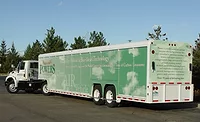Hybrid beverage fleets face challenges
Next-generation advancements stifled by policy
In spite of generally positive performance out on the road, diesel-electric hybrid drivetrains have had less than stellar success in the North American truck market. So much so that Eaton Corp., a manufacturer of hybrid components, has recently announced that it will discontinue offering hybrid drivetrains in North America.
Perhaps the single-largest factor in the weak market for hybrids has been the (temporary) stabilization of diesel fuel prices at a level somewhat lower than necessary for a quick payoff on the hybrid investment. Although not specifically competitive with hybrid hardware, interest and investment in natural-gas-powered drivetrains also have had negative impacts on hybrid adoption.
Nevertheless, Eaton reported that it still is pursuing hybrid technology in Europe and China, where transit buses are a popular application for the technology. The company also confirmed that it will continue to support its existing hybrid trucks in North America.
Energy policy lacking
These events serve as another example of the need for a coherent, long-term energy policy here in the United States. Just like the iPhone or any other technology-based product, commercial truck hybrid drivetrains will require a product generation or two before performance is fully optimized and production costs are reduced to the point of being compatible with fuel prices less than $4 a gallon.
About the time that diesel-electric hybrid trucks began to enter the market in significant numbers, tax incentives for the purchase of heavy-duty hybrid vehicles expired Dec. 31, 2009. Absent the tax incentives and/or higher fuel prices, the business case for the unfamiliar, nascent hybrid technology became too tough to sell to fleets already under financial pressure from the weak economy.
According to the U.S. Energy Information Administration’s “Alternatives to Traditional Transportation Fuels 2011 report,” 67,295 electric/battery alternative vehicles were in use in 2011. Of those, 87 were medium-duty vehicles, and 779 were heavy-duty vehicles. Given these numbers and timeframe, there just hasn’t been enough time or sales volume to push production costs down to mass-market levels.
It’s not as if the hybrid technology hasn’t already been delivering real-world benefits and better-than-expected performance; it just hasn’t had the opportunity to mature or to reach an economy of scale.
We’ve been experimenting with wind power for hundreds of years, and subsidizing it for more than a decade, yet it still hasn’t scaled up to commercial viability. Meanwhile, the diesel-electric hybrids were already on their way to commercial viability in just a few short years, before the short-sighted energy policy shot the market out from under the technology.
Regardless of whether a truck is fueled with diesel or natural gas, the hybrid technology has a proven track record of reducing exhaust emissions and cutting fuel use. Long-subsidized biofuels, on the other hand, do nothing to reduce actual emissions or to cut fuel use.
Beverage fleets lead hybrid market
Beverage fleet operators were among the earliest adopters of diesel-electric hybrid technology, and although exact sales numbers are closely guarded, they also represent a large portion of the non-municipal customer segment for hybrid trucks. In spite of working with the earliest stages of hybrid technology allowed outside of manufacturers’ labs or test tracks, the problems reported by my hybrid fleet contacts have been negligible to nil.
Without any previous experience to go by, both the manufacturers and the early hybrid buyers were rightfully concerned with the potential lifespan of the hybrid system batteries, which represent a significant portion of the total system cost. Here again, even with the earliest technology in play, the experience has been positive.
At Orion, Mich.-based Powers Distributing, Chief Operations Officer Gary Thompson indicates that most of his fleet’s hybrid batteries have lasted longer than expected. “Only one or two trucks out of over 20 required replacement earlier than expected,” he said. “We purchased extended-battery-life warranties, so the cost has not been great.”
Fuel economy with the hybrid drivetrains also has been as good or better than projected. Even though no two delivery operations are exactly the same, the truck manufacturers originally made cautious predictions of fuel economy improvements in the range of 25-30 percent. Most of the fleets I’ve queried throughout the last few years have reported fuel economy savings of at least 30 percent. At Powers Distributing, Thompson says that his Kenworth and Peterbilt hybrids are saving in excess of 70 percent, compared with pre-2007 engines, while his International Trucks and Engine Corp. hybrids are closer to 35 percent in fuel savings.
Moving forward
The fact that Eaton is continuing development of hybrid hardware for other global markets is encouraging. Once the technology has another generation or two in place, both production costs and operating efficiency will undoubtedly improve.
With hybrid costs going down and fuel cost stability in question, it’s just a matter of time before there’s once again a viable business case for hybrids.
Looking for a reprint of this article?
From high-res PDFs to custom plaques, order your copy today!




